Blackwall, London
Blackwall is a locale in East London, located in the London Borough of Tower Hamlets, it includes[2] Leamouth and the conservation area of Coldharbour.
| Blackwall | |
|---|---|
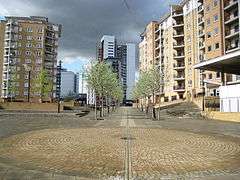 Virginia Quay, the line that runs down the centre of the avenue marking the prime meridian | |
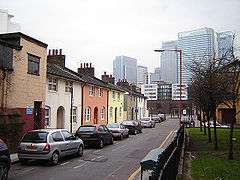 St Lawrence Cottages, a rare survivor of the old Blackwall | |
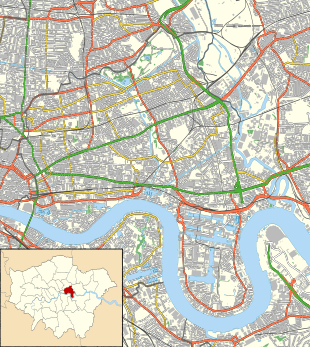 Blackwall  Blackwall Location within Greater London | |
| Population | 19,461 (2011 Census. Blackwall and Cubitt Town Ward)[1] |
| OS grid reference | TQ385805 |
| London borough | |
| Ceremonial county | Greater London |
| Region | |
| Country | England |
| Sovereign state | United Kingdom |
| Post town | LONDON |
| Postcode district | E14 |
| Dialling code | 020 |
| Police | Metropolitan |
| Fire | London |
| Ambulance | London |
| UK Parliament | |
| London Assembly | |
The area takes its name from a historic stretch of riverside wall built along an outside curve of the Thames, to protect the area from flooding. While mostly residential, Blackwall Yard here provides moorings for vessels.
History
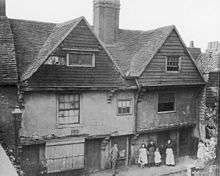
Blackwall name presumably derives from the colour of the river wall, built in the Middle Ages with its stairs. It was known as Blackwall by at least the 14th century.[4]
Blackwall Yard became a major sea hub. In 1576, Martin Frobisher left Blackwall (then part of Poplar) and landed at Frobisher Bay on Baffin Island, claiming it for England (its first overseas possession) in the name of Queen Elizabeth I. Frobisher was funded by the Muscovy Company seeking the North West Passage.[5][6]
The area was historically part of the parish of Poplar in Middlesex. The area lay in a sheltered loop of the river next to Poplar's East Marsh, where the East India Docks were constructed at the beginning of the 19th century. The area has never had its own Anglican church, so services such as road maintenance were organised by a vestry, and for poor relief it relied on its ecclesiastical parish (of All Saints) Poplar.[7] Indeed, the whole Isle of Dogs was until the late 20th century referred to as being Poplar or the Poplar District.[8]
Leamouth Wharf (then part of Blackwall) was associated with the Samuda Brothers, Orchard House Yard and Thames Iron Works shipyards which were the centers of employment. To provide housing for the workers, 100 small cottages – were developed from the 1820s.[9] There was the Bow Creek school (founded in 1865), but few shops, and The Crown, a public house, opened about 1840.[10]
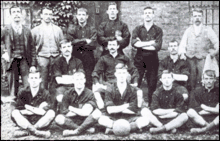
Blackwall's Thames Iron Works at Leamouth Wharf gave birth in 1895 to works team Thames Ironworks F.C. which was founded by owner Arnold Hills and foreman Dave Taylor. The club would later be reformed as West Ham United F.C.[11][12]
The London and Blackwall Railway was one of the earliest railway systems in London, operating from 1840. it was also one of the smallest running from Fenchurch Street Station in the city to Blackwall, a trip which lasted less than twenty minutes, but which was very important in terms of serving the passenger services at Gravesend.
Near the Blackwall railway station was constructed the Brunswick Hotel which was located on the Greenwich Meridian line. In its early years, it apparently attracted a fairly elegant crowd, including William IV on an occasion connected with the opening or expansion of the burgeoning docks in the area. Its prime customer base was emigrants (usually to Australia) who would wait here until they could board small steamers to take them to the large sea-going liners at Gravesend. In the days of sail, such clients might have to wait for days or weeks until the winds were favourable, by the end of the century the substitution of steam power and rail links on the south bank of the Thames greatly reduced the viability of the Hotel. No evidence remains of either the hotel (demolished in the 1920s) or the Railway Station (demolished 1946) they stood between Jamestown Way and the Thames.
Blackwall gives its name to the partially underlying London County Council (LCC) built single bore Blackwall Tunnel designed by Sir Alexander Binnie and built by S. Pearson & Sons as part of a major transport project to improve commerce and trade in the East End, that opened in 1892–1897, starting at Poplar which passes south under Blackwall and the adjacent River Thames to the then East Greenwich.[13][14]
The Brunswick Wharf Power Station was built by Poplar Borough Council for the British Electricity Authority (BEA) in 1952, on the site of the former East India Export Dock. The power station was controversial due to both potential air pollution in a densely populated part of London.[15]
In the 1950s, the Isle of Dogs excluded the symmetrical part (that is, its northwest, forming the parish of Limehouse) and comprises "the ancient hamlet of Poplar itself, the old shipbuilding centre of Blackwall, and the former industrial districts of Millwall and Cubitt Town. Poplar’s story is one of development and redevelopment on both the grand and the comparatively small scale, driven in the nineteenth century by mercantile interests and manufacturing, and after the Second World War by de-industrialization and the obsolescence of the Thames-side docks... [In recent times] a major subject is public housing, which includes the famous Lansbury Estate, built in association with the 1951 Festival of Britain."[16]
Contrary to expectations, the River Thames landmark named Blackwall Point is not in Blackwall district but on the north tip of Greenwich Peninsula, which is south of the Thames. It is so named after the Blackwall Reach of the Thames.
The 1980s, Blackwall saw the area first redevelopment project, a luxury housing complex called Jamestown Harbour over the Blackwall Basin, designed by WCEC Architects for the Wates Group and was completed by 1985. Jamestown Harbour was one of the first housing developments of the London Docklands. With its brick-built warehouse-style exteriors and distinctive blue and red balconies, it was designed to recreate the appearance of traditional river and dockside warehouses.[17]
In the 2000s, a residential development New Providence Wharf began to be built, which was designed and built by Skidmore, Owings & Merrill and Ballymore Group and saw the Ontario Tower and Providence Tower (now the Charrington Tower) completed in 2007 and 2016 respectively.[18][19]
Geography
Blackwall has never been an administrative unit and so lacks any formal definition, but it can be broadly described as the areas close to Thames on the north-east part of the Isle of Dogs peninsula extending eastward to the confluence of the Thames and Lea.
Industry
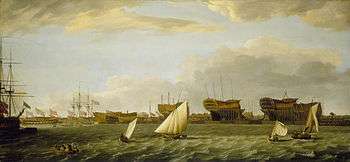
Blackwall was a significant part of the ocean-going port called the Port of London, connected with important voyages for over 400 years. On 7 June 1576, financed by the Muscovy Company, Martin Frobisher set sail from Blackwall, seeking the North West Passage.[5] Walter Raleigh had a house at Blackwall, and in the early years of the 17th century the port was the main departure point of the English colonization of North America and the West Indies launched by the London Company.
Until 1987, Blackwall was a centre of shipbuilding and repairing. This activity principally included Blackwall Yard, the Thames Ironworks and Shipbuilding Company at Leamouth, Canning Town (part of whose works spanned the very informal border of the very small one-road, one unit deep area of Leamouth), and the Orchard House Yard. Blackwall Yard (two of whose former dry docks can still be seen around the present-day Reuters building) built the first Blackwall Frigates.
Blackwall today is still a part of the Port of London as Northumberland Wharf is still retained as a working wharf, this has special status by the Mayor of London and the Port of London Authority (PLA) as a safeguarded wharf. It is run by Cory Riverside Energy who also managed the Reuse and Recycling Centre which is next to the wharf and for the transportation of waste by barge along the River Thames.[20][21]
Heritage
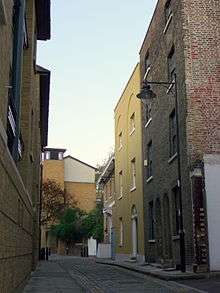
Coldharbour is said to be "[t]he sole remaining fragment of the old hamlet of Blackwall" and "one of the last examples of the narrow streets which once characterised the river's perimeter".[22] It is today largely residential and no longer has any industrial and maritime activities. The Coldharbour Conservation Area, designated in 1975 and then expanded in 2008, has several listed historic buildings as well as engineering structures once part of the former docks.[23]
Transport
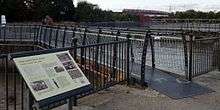
- Historic
The former London and Blackwall Railway ran from Minories to Blackwall by way of Stepney, a distance of three and half miles. This was authorised in 1836 as "The Commercial Railway", running close to Commercial Road in the East End of London to the Blackwall railway station.[24]
- Contemporary
A relatively wide physical divide for a peripheral-to-East London district separates Poplar, London from Blackwall, the A1261. The twin north-south tunnels forming the Blackwall Tunnel commence 250 metres (820 ft) north of this road, by the local borough Town Hall, within the edge of Poplar.
London Buses routes D3 on west-east Blackwall Way, and D6, D7 and N550 on north-south Preston Road give local access to neighbouring Poplar, Leamouth, the Isle of Dogs and Canary Wharf.
The Thames Path (north bank) National Trail which opened in 1996 is connected to Blackwall, it enters the district at the South Dock Entrance and goes via Coldharbour and Blackwall Way and rejoins the River Thames at Virginia Wharf till the East India Dock at Blackwall Point.[25][26]
Media
- A fictitious Blackwall Fire Station is featured in the London Weekend Television series London's Burning.
Education
Sport
A wide range of gyms and a small leisure centre are at nearby Canary Wharf.
References
- "Tower Hamlets Ward population 2011". Neighbourhood Statistics. Office for National Statistics. Archived from the original on 21 October 2016. Retrieved 16 October 2016.
- "Description of old Blackwall, including the inclusion of Coldharbour and its eastern boundary at the Lea".
- Photograph taken c. 1890, now in the National Maritime Museum, ID: H0657
- Old Blackwall, Survey of London: volumes 43 and 44: Poplar, Blackwall and Isle of Dogs (1994), pp. 548-552 accessed: 5 November 2007
- The Nunavut Voyages of Martin Frobisher at web site of the Canadian Museum of Civilization, accessed 5 August 2011
- Cooke, Alan (1979) [1966]. "Frobisher, Sir Martin". In Brown, George Williams (ed.). Dictionary of Canadian Biography. I (1000–1700) (online ed.). University of Toronto Press.
- Church of England Website Poplar ecclesiastical parish map
- A Survey of London 1994, Hermione Hobhouse (Gen. Ed.)
- The cottages typically consisted of four rooms and a wash-house.
- Charles Lammin Memories of Orchard House (East London History Society, 1961)
- "East London History regarding Thames Ironworks". EastLondonHistory.com. Archived from the original on 13 February 2006.
- "Pg24, citing study into West Hams community ties" (PDF). Leeds Metropolitan University. Archived from the original (PDF) on 17 January 2005.
- Hermione Hobhouse, ed. (1994). Southern Blackwall: The Blackwall Tunnel. Survey of London. 43 and 44 : Poplar, Blackwall and Isle of Dogs. London. pp. 640–645. Retrieved 30 August 2017.
- Smith, Denis (2001). London and the Thames Valley. Thomas Telford. p. 15. ISBN 978-0-7277-2876-0.
- Hobhouse, Hermione, ed. (1999) [1994]. "XXI Brunswick Wharf". volumes 43 and 44: Poplar, Blackwall and Isle of Dogs, the Parish of All Saints. Survey of London. London: Continuum International Publishing Group. pp. 593–600. ISBN 0-485-48244-4. Retrieved 31 October 2011.
- "Survey of London: Volumes 43 and 44, Poplar, Blackwall and Isle of Dogs". British History Online. Retrieved 9 May 2018.
- "Jamestown Harbour". www.landonsclose.co.uk.
- "BALLYMORE ANNOUNCES THE LAUNCH OF PROVIDENCE TOWER, CANARY WHARF". knightfrank.co.uk. Retrieved 29 August 2014.
- "Ontario Tower & Radisson Hotel". Watts Group Ltd. Retrieved 27 June 2017.
- Christou, Marianna (19 September 2017). "Cory confirmed as preferred bidder for Tower Hamlets contract".
- "Cory Awarded 10-Year Tower Hamlets Waste Contract". 10 October 2017.
- LBTH. 2007. Coldharbour Conservation Area. Archived 19 August 2014 at the Wayback Machine London Borough of Tower Hamlets.
- London Borough of Tower Hamlets. 2009. Coldharbour Conservation Area. Archived 1 September 2012 at the Wayback Machine
- Awdry, Christopher (1990). Encyclopaedia of British Railway Companies. London: Guild Publishing. p. 144. CN 8983.CS1 maint: ref=harv (link)
- "Thames Path_north bank_route_section-four" (PDF). Retrieved 29 August 2018.
- "Thames Path - Ramblers". www.ramblers.org.uk. Retrieved 24 November 2014.
External links
| Wikimedia Commons has media related to Blackwall, London. |
